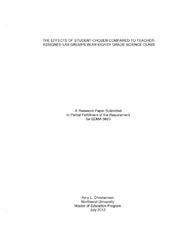| dc.contributor.author | Christiansen, Amy L. | en |
| dc.date.accessioned | 2017-10-02T22:34:37Z | |
| dc.date.available | 2017-10-02T22:34:37Z | |
| dc.date.issued | 2012-07 | en |
| dc.identifier.uri | archives.northwestu.edu/handle/nu/25702 | |
| dc.description.abstract | There has been an ongoing conversation in my eighth grade science class to determine whether I should allow students to choose whom they work with or if I should assign their groups. Previous education methodology courses suggest that I am more qualified to create groupings to ensure students are supported effectively. However, some situations where students are able to choose who they work with have produced higher levels of achievement. Therefore, I measured the productivity rates of students in teacher-assigned compared to student-chosen lab groups. I used an experimental quantitative approach to observe the amount of time all students are engaged in the lab using a collaborative learning model compared to the total amount of time for the lab to find the productivity rate. Additionally, I used a 5-point Likert scale to qualitatively measure student attitudes toward group work before and after the study to compare perceived productivity and observed productivity. Results showed that student-chosen groups had an average productivity rate of 92%, which exceeded the teacher-assigned rate of 81%. Student attitude survey results indicated that students liked choosing their own groups more with 87% agreement in post test scores. Therefore, attitude positively correlated with productivity. Additional findings were that students were the most productive during the hands-on portion of the lab, less productive during the guiding questions discussion portion of the activity, and least on-task during direct instruction before and after the lab. This indicated that interest is also positively correlated with productivity. However, there were behavior management and safety issues that interfered with some students achieving the learning objective to the point that allowing students to choose their own group was detrimental. Conclusions from this study suggest that students can be more successful in a collaborative learning environment when they are allowed to choose their own groups and that their positive attitude toward this condition increases productivity. Moving forward, students should be allowed to choose their own groups given that they have a structured framework such as a collaborative learning model and as long as students are not significantly negatively affected by this grouping. Professional judgment in teacher-assigned groupings in this case created an overall successful learning environment and can also be used for an adequately productive experience. | en |
| dc.format.extent | 40 pages | en |
| dc.format.medium | PDF | en |
| dc.language.iso | en | en |
| dc.publisher | Northwest University | en |
| dc.rights | This original work is protected by copyright. Copyright is retained by the author(s). Works may be viewed, downloaded, or printed, but not reproduced or distributed without author(s) permission. | en |
| dc.rights.uri | http://archives.northwestu.edu/page/copyright | en |
| dc.subject | Science | en |
| dc.title | The Effects of Student-Chosen Compared to Teacher Assigned Lab Groups in An Eighth Grade Science Class | en |
| thesis.degree.name | Master of Education | en |
| thesis.degree.level | Masters | en |
| thesis.degree.grantor | Northwest University | en |
| thesis.degree.discipline | College of Education | en |


 Maintained by the Northwest University Library
Maintained by the Northwest University Library